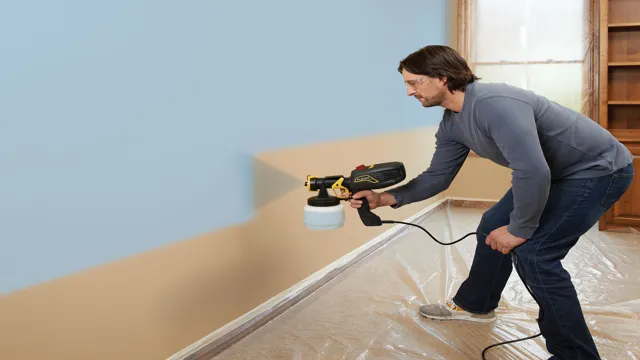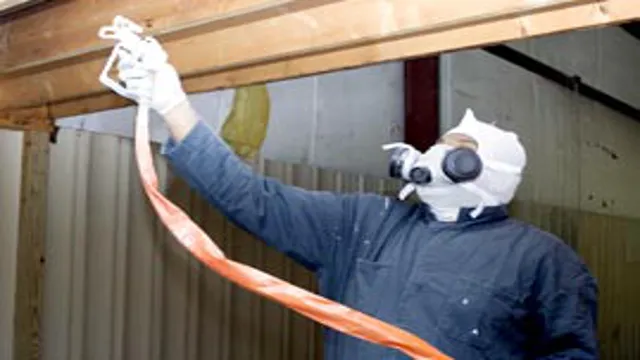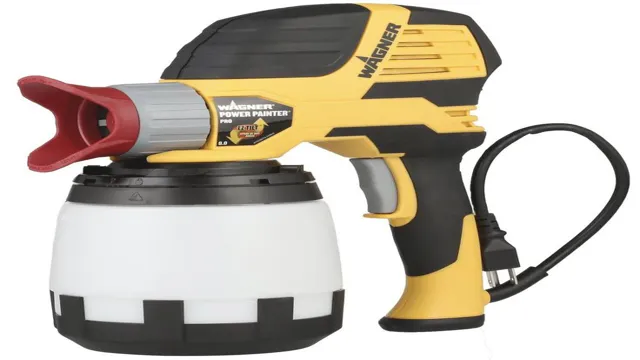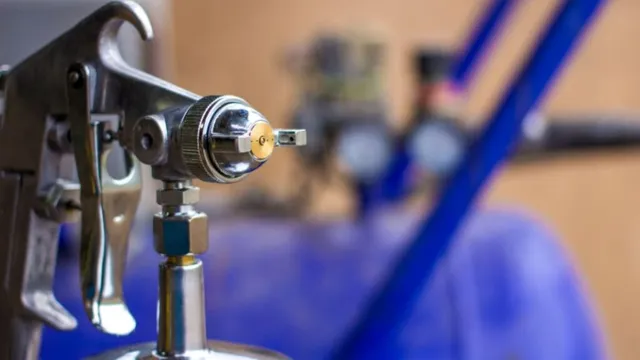Can I Use a Paint Sprayer Inside Without Making a Mess? Here’s What You Should Know.

Are you looking to paint the inside of your home, but feeling unsure about using a paint sprayer indoors? It’s natural to feel hesitant – using a paint sprayer inside can feel overwhelming, and there are many factors to consider when deciding whether or not to take on the job. In this comprehensive guide, we’ll take you through everything you need to know about using a paint sprayer inside your home. From choosing the right sprayer and paint, to preparing your space and avoiding common mistakes, we’ll cover it all.
You’ll learn how to paint your walls and ceilings quickly, efficiently, and cleanly – all while achieving a professional-looking finish. By the end of this guide, you’ll feel confident in your ability to tackle this project, and your home will be looking better than ever. So let’s dive in and get started!
Safety First
If you’re looking to update the look of your home, painting is a great way to achieve that. However, you may be wondering if it’s safe to use a paint sprayer inside. The answer is yes, but with some important caveats.
First, make sure you have adequate ventilation and wear a respirator mask to protect against any harmful fumes. It’s also important to cover any furniture or floors with drop cloths to protect them from overspray. Before starting, do a test spray in a small area to see if the sprayer might cause any damage.
Always read the manufacturer’s instructions carefully and follow them to ensure safe use of the paint sprayer. Remember, safety should always be your top priority when using any kind of tool or equipment. With proper precautions in place, you can safely achieve a professional-looking paint job with a paint sprayer inside your home.
Protective Equipment
When it comes to staying safe at work, protective equipment is an absolute must-have. This includes everything from hard hats and safety goggles to gloves and steel-toed boots. In fact, protective gear can be the difference between a simple accident and a life-altering injury.
But it’s not just about wearing the gear; it’s about wearing it properly. Workers need to be trained on how to properly wear and care for their protective equipment to ensure its effectiveness. It’s like wearing a bike helmet; it only works if worn correctly.
So, always remember, safety first, and make sure you’re using the right protective equipment for the job.

Ventilation
When it comes to ventilation, safety should always be the top priority. Proper ventilation not only helps maintain a comfortable indoor atmosphere, but it also promotes good health by keeping the air clean and free of harmful pollutants. Poor ventilation, on the other hand, can lead to a multitude of problems ranging from increased risk of illness to potential fire hazards.
To ensure the safety of your home or workplace, it is important to make sure that your ventilation system is functioning properly and is well-maintained. This means regularly checking and cleaning air filters, making sure air ducts are free of blockages, and addressing any issues as soon as they arise. By prioritizing safety in your approach to ventilation, you can enjoy a healthy and comfortable indoor environment for years to come.
Prep Your Work Area
Before you start any DIY project, you must make sure that your work area is safe. The last thing you want is to accidentally hurt yourself or someone else because you didn’t take the necessary safety precautions. The first step in securing your work area is to remove any potential hazards, such as loose objects, tripping hazards, or flammable materials.
Make sure to clear the area of any obstacles and ensure that you have enough space to move around freely. Additionally, make sure that you have the appropriate safety gear, such as gloves, protective glasses, and masks. Not only will this protect you from accidents, but it’ll also help you get your work done effectively and efficiently.
Remember, safety is key when it comes to any DIY project, so take the time to prep your work area before you begin.
Choosing the Right Paint Sprayer for Indoor Painting
If you’re wondering whether you can use a paint sprayer for indoor painting, the answer is yes, you can. With the right equipment and precautions, paint sprayers can be an excellent choice for interior painting projects. However, choosing the right paint sprayer is crucial.
You’ll want one that is specifically designed for indoor use, so that you can avoid causing any damage to your home and health. You’ll also want to consider the size of the job and the type of paint you’ll be using when selecting your sprayer. A greater job will require a more robust sprayer, whereas a smaller job with more intricate details may warrant a smaller sprayer.
The type of paint you plan to use will also influence your decision, as not all sprayers are designed to work with thicker paints like latex. Ultimately, carefully researching the available options and talking to paint experts can help you choose the right sprayer to complete your indoor painting project with ease.
HVLP vs. Airless Sprayers
Choosing the right paint sprayer for indoor painting can be a daunting task, especially if you’re not familiar with the different types available. Two popular options are HVLP and airless sprayers. HVLP (high volume, low pressure) sprayers are ideal for smaller indoor projects as they produce less overspray, making them suitable for delicate surfaces such as furniture or cabinets.
On the other hand, airless sprayers are perfect for larger indoor projects like walls, ceilings, and fences, thanks to their ability to cover large areas quickly and evenly. When selecting a sprayer, it’s essential to consider the type of paint you’re using. HVLP sprayers work well with thinner paints and stains, while airless sprayers can handle thicker paints like latex or enamel.
Overall, understanding the differences in sprayers and their capabilities will help you make an informed decision and choose the best one for your indoor painting needs.
Paint Types
When it comes to indoor painting, choosing the right paint sprayer can make all the difference. One of the most important factors to consider is the type of paint you will be using. There are several paint types on the market, including latex, oil-based, and enamels.
Latex paint is a popular choice for indoor painting due to its quick drying time and easy cleanup with soap and water. Oil-based paint, on the other hand, offers a durable finish but requires solvents for cleanup. Enamel paint is known for its hard, glossy finish, making it an ideal choice for furniture and cabinets.
But regardless of which paint type you choose, be sure to select a paint sprayer that is compatible with your paint. This will not only ensure an even application but also save you time and frustration in the long run.
Sprayer Size and Capacity
When it comes to indoor painting, choosing the right paint sprayer can make all the difference. One important factor to consider is the size and capacity of the sprayer. A smaller sprayer with a lower capacity may be suitable for small jobs like touching up trim or painting a single wall.
However, larger projects like painting an entire room or multiple rooms may require a larger sprayer with a higher capacity. Keep in mind that a larger sprayer may be heavier and more challenging to maneuver, so it’s important to choose a size and capacity that fits your needs and abilities. By selecting the right sprayer size and capacity, you can save time, reduce frustration, and achieve the best possible outcome for your indoor painting project.
Tips for Successful Indoor Painting with a Sprayer
If you’re thinking about using a paint sprayer inside your home, the answer is yes, you can! However, there are a few things to keep in mind before you start spraying away. First, make sure you have proper ventilation to avoid inhaling fumes and to reduce the risk of fire. Open windows and use fans to keep the air moving.
Next, take the time to properly prep your space, covering floors, furniture, and areas you don’t want painted. This will make cleaning up much easier. Finally, practice with your sprayer before you start your project to get a feel for how it works and to avoid any surprise drips or splatters.
With these tips in mind, using a paint sprayer inside can be a great way to update your home’s look efficiently and effectively.
Adjust Your Spray Pattern
Adjusting your spray pattern is essential for successful indoor painting with a sprayer. The spray pattern determines the width and shape of the paint spray, which affects the smoothness and consistency of the application. To adjust the spray pattern, you need to adjust the nozzle or tip of the sprayer.
Different nozzles or tips come with different spray patterns and sizes. You can select a narrow or wide spray pattern depending on the object you’re painting, the type of paint you’re using, and the desired finish. For instance, if you’re painting a small object, such as a chair, you can use a narrow spray pattern to avoid overspray and achieve precision.
On the other hand, if you’re painting a large area, such as a wall, you can use a wide spray pattern to cover more surface in a shorter time. By adjusting your spray pattern, you can make your indoor painting project easier, more efficient, and more satisfying.
Maintain Consistent Distance
When painting indoors with a sprayer, it’s crucial to maintain a consistent distance between the sprayer and the surface you’re painting. This will ensure that the paint is applied evenly and with the right amount of pressure, resulting in a smooth, professional-looking finish. A good rule of thumb is to hold the sprayer 6-8 inches away from the surface at all times.
Additionally, it’s important to keep your movements fluid and steady, avoiding sudden stops or jolts that can cause the paint to clump or streak. In short, taking the time to master the art of maintaining consistent distance is key to achieving a successful indoor painting project with a sprayer.
Spray in a Controlled Manner
Paint sprayers are a wonderful tool for speeding up painting projects, and they can be especially beneficial when refinishing furniture or cabinetry. However, using a sprayer can be tricky, and if not done correctly, it can result in a mess. To spray in a controlled manner, first, choose the right tool for the job.
A smaller sprayer may work well for tight spaces or small projects, whereas a larger one may be necessary for larger areas. Next, ensure that the surface to be painted is clean and free from debris. Then, practice on a piece of scrap wood or cardboard before spraying the object itself, as this will help you get a feel for the tool and ensure that you don’t overspray or under-spray.
Finally, keep the sprayer at a consistent distance from the surface and move it side-to-side slowly and steadily, using even strokes to maintain a consistent pattern. By following these tips, you can successfully use a sprayer to complete your indoor painting projects with ease and precision.
Cleaning and Maintenance
One question that frequently arises when it comes to painting is whether or not you can use a paint sprayer inside. The answer is yes, but with some precautions. First and foremost, you need to ensure that you have proper ventilation.
Open windows and doors and use fans to circulate the air. Additionally, cover floors and furniture with drop cloths and tape off any areas you don’t want to be painted. It’s also crucial that you wear protective gear like a mask and goggles to avoid inhaling any fumes or getting paint in your eyes.
Using a paint sprayer indoors can be a time and cost-effective way to get an even coat quickly and easily. Just make sure you follow safety guidelines and take proper precautions to keep yourself and your home safe.
Cleaning Your Sprayer
Cleaning Your Sprayer Maintaining and cleaning your sprayer regularly can prolong its lifespan and improve its performance. A well-maintained sprayer is a more effective and efficient tool for applying pesticides, herbicides, and fertilizers. The first step in cleaning your sprayer is to remove any excess liquid and debris.
Then, you should rinse the tank and all the nozzles with water. It’s also important to clean the filters and check for any clogs. If you find any clogs, clear them thoroughly.
A mix of water and a cleaning solution can also be used to clean the tank and nozzles. Be sure to rinse the sprayer thoroughly after using a cleaning solution to prevent any residue from affecting the next application. Finally, store your sprayer in a cool and dry place to prevent rust or damage while not in use.
With proper and regular maintenance, your sprayer can provide you with several years of efficient and effective use.
Storage and Maintenance
When it comes to storage and maintenance of your possessions, cleaning is an essential aspect to ensure that everything stays in optimal condition. Whether it’s your furniture, clothing, or electronics, regular cleaning and maintenance will extend the lifespan of your items, saving you money in the long run. For instance, wiping down your furniture with a microfiber cloth and vacuuming it regularly will prevent dust and dirt from accumulating, preventing any stains or damage.
Similarly, maintaining your electronics like laptops and smartphones is essential to ensure that they don’t slow down or become damaged due to excessive dirt and grime. Along with cleaning, it’s also vital to store your items correctly in a dry and cool place away from direct sunlight and moisture. Taking these simple measures will help keep your belongings in pristine condition and save you from costly replacements.
Conclusion: Yes, You Can Use a Paint Sprayer Indoors
In conclusion, can you use a paint sprayer inside? The answer is yes, but with caution and proper preparation. Make sure to cover and protect any surfaces that might get splattered, wear appropriate protective gear, and ensure proper ventilation. Using a paint sprayer inside can save you time and effort, but it’s essential to follow safety guidelines to avoid any unwanted mishaps.
As Bob Ross once said, “We don’t make mistakes, just happy accidents.” However, with paint spraying, it’s better to not leave things to chance and ensure that your painting project ends up as a masterpiece.”
FAQs
Is it safe to use a paint sprayer inside?
Yes, you can use a paint sprayer inside, but make sure the area is well-ventilated and you wear proper protective gear.
Do I need a special type of paint for a paint sprayer to use inside?
No, you can use any type of paint with a paint sprayer, but make sure to read the manufacturer’s instructions.
Is using a paint sprayer more efficient than using a paint roller inside?
Yes, using a paint sprayer can be more efficient as it covers larger areas in less time, but it’s important to properly prepare the surface before spraying.
Can I use a paint sprayer inside without creating a mess?
Yes, you can minimize the mess by properly covering the surrounding areas and using an appropriate sprayer tip.
Do I need to thin the paint before using a paint sprayer indoors?
It depends on the type of paint and manufacturer’s instructions, some paints do require thinning before use with a paint sprayer.
Can I use a paint sprayer inside for small jobs like furniture or cabinets?
Yes, a paint sprayer is a great tool for small jobs as it provides a smooth and even finish.
How do I clean a paint sprayer after using it inside?
Follow the manufacturer’s instructions for cleaning a paint sprayer, and make sure to properly dispose of any leftover paint or cleaning solutions.



